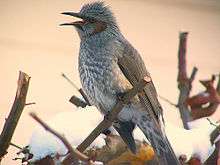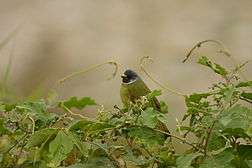Bulbul
The bulbuls are a family, Pycnonotidae, of medium-sized passerine songbirds, and includes the greenbul, brownbul, leaflove, and bristlebill. The family is distributed across most of Africa and into the Middle East, tropical Asia to Indonesia, and north as far as Japan. A few insular species occur on the tropical islands of the Indian Ocean. There are over 150 species in 27 genera. While different species are found in a wide range of habitats, the African species are predominantly found in rainforest, whereas Asian bulbuls are predominantly found in more open areas.
| Bulbul | |
|---|---|
 | |
| Brown-eared bulbul (Hypsipetes amaurotis) | |
| Scientific classification | |
| Kingdom: | Animalia |
| Phylum: | Chordata |
| Class: | Aves |
| Order: | Passeriformes |
| Infraorder: | Passerida |
| Family: | Pycnonotidae Gray, GR, 1840 |
| Genera | |
|
See text | |
| Synonyms | |
| |
Taxonomy and systematics
Etymology
The word bulbul derives from Hindi (बुलबुल) or Persian or Arabic (بلبل),[1][2] meaning nightingale,[3] but in English, bulbul refers to passerine birds of a different family.
Taxonomy
The traditional layout was to divide the bulbuls into four groups, named Pycnonotus, Phyllastrephus, Criniger, and Chlorocichla groups after characteristic genera (Delacour, 1943). However, more recent analyses demonstrated that this arrangement was probably based on erroneous interpretation of characteristics.
Comparison of mtDNA cytochrome b sequences found that five species of Phyllastrephus did not belong to the bulbuls, but to an enigmatic group of songbirds from Madagascar instead (Cibois et al., 2001; see below for the species in question), and they are now usually referred to as Malagasy warblers. Similarly, sequence analysis of the nDNA RAG1 and RAG2 genes suggests that the genus Nicator is not a bulbul either (Beresford et al., 2005). That the previous arrangement had failed to take into account biogeography was indicated by the study of Pasquet et al. (2001) who demonstrated the genus Criniger must be divided into an African and an Asian (Alophoixus) lineage. Using analysis of one nDNA and 2 mtDNA sequences, Moyle & Marks (2006) found one largely Asian lineage and one African group of greenbuls and bristlebills; the golden greenbul seemes to be very distinct and form a group of its own. Some taxa are not monophyletic, and more research is necessary to determine relationships within the larger genera.
Systematic list
Currently, there are 158 recognized species in 32 genera:[4]
- Genus Andropadus – 1 species (sombre greenbul)
- Genus Stelgidillas – 1 species (slender-billed greenbul)
- Genus Calyptocichla – 1 species (golden greenbul)
- Genus Neolestes – 1 species (black-collared bulbul)
- Genus Bleda – 5 species of bristlebills
- Genus Atimastillas – 1 species (yellow-throated leaflove)
- Genus Ixonotus – 1 species (spotted greenbul)
- Genus Thescelocichla – 1 species (swamp palm bulbul)
- Genus Chlorocichla – 5 species of greenbuls
- Genus Baeopogon – 2 species of greenbuls
- Genus Arizelocichla – 12 species of greenbuls
- Genus Criniger – 5 species of greenbuls
- Genus Eurillas – 5 species of greenbuls
- Genus Phyllastrephus – 20 species of greenbuls and brownbuls
- Genus Tricholestes – 1 species (hairy-backed bulbul)
- Genus Setornis – 1 species (hook-billed bulbul)
- Genus Alophoixus – 8 species
- Genus Alcurus – 2 species
- Genus Iole – 7 species
- Genus Hemixos – 4 species
- Genus Acritillas – 1 species (yellow-browed bulbul)
- Genus Ixos – 4 species
- Genus Hypsipetes – 19 species (including 3 species formerly assigned to Thapsinillas and one assigned to the monotypic genus Cerasophila)
- Genus Euptilotus – 1 species (puff-backed bulbul)
- Genus Microtarsus – 1 species (black-and-white bulbul)
- Genus Poliolophus – 1 species (yellow-wattled bulbul)
- Genus Brachypodius – 4 species
- Genus Ixodia – 3 species
- Genus Rubigula – 5 species
- Genus Nok – 1 species (bare-faced bulbul)
- Genus Spizixos – 2 species of finchbills
- Genus Pycnonotus – 32 species (substantially reduced from previous circumscriptions)
Description
Bulbuls are short-necked slender passerines. The tails are long and the wings short and rounded. In almost all species the bill is slightly elongated and slightly hooked at the end. They vary in length from 13 cm for the tiny greenbul to 29 cm in the straw-headed bulbul. Overall the sexes are alike, although the females tend to be slightly smaller. In a few species the differences are so great that they have been described as functionally different species. The soft plumage of some species is colorful with yellow, red or orange vents, cheeks, throat or supercilia, but most are drab, with uniform olive-brown to black plumage. Species with dull coloured eyes often sport contrasting eyerings. Some have very distinct crests. Bulbuls are highly vocal, with the calls of most species being described as nasal or gravelly. One author described the song of the brown-eared bulbul as "the most unattractive noises made by any bird".[3]
Behaviour and ecology
Breeding
The bulbuls are generally monogamous. One unusual exception is the yellow-whiskered greenbul which at least over part of its range appears to be polygamous and engage in a lekking system. Some species also have alloparenting arrangements, where non-breeders, usually the young from earlier clutches, help raise the young of a dominant breeding pair. Up to five purple-pink eggs are laid in an open tree nests and incubated by the female. Incubation usually lasts between 11–14 days, and chicks fledge after 12–16 days.
Feeding
Bulbuls eat a wide range of foods, ranging from fruit to seeds, nectar, small insects and other arthropods and even small vertebrates. The majority of species are frugivorous and supplement their diet with some insects, although there is a significant minority of specialists, particularly in Africa. Open country species in particular are generalists. Bulbuls in the genus Criniger and bristlebills in the genus Bleda will join mixed-species feeding flocks.
Relationship to humans
The red-whiskered bulbuls and red-vented bulbuls have been captured for the pet trade in great numbers and have been widely introduced to tropical and subtropical areas, for example southern Florida, Fiji, Australia and Hawaii. Some species are regarded as crop pests, particularly in orchards.
In general bulbuls and greenbuls are resistant to human pressures on the environment and are tolerant of disturbed habitat. Around 13 species are considered threatened by human activities, mostly specialised forest species threatened by habitat loss.
References
- Beresford, P.; Barker, F.K.; Ryan, P.G.; Crowe, T.M. (2005). "African endemics span the tree of songbirds (Passeri): molecular systematics of several evolutionary 'enigmas'". Proc. Roy. Soc. Lond. B. 272 (1565): 849–858. doi:10.1098/rspb.2004.2997. PMC 1599865. PMID 15888418.
- Cibois, Alice (2001). "AN ENDEMIC RADIATION OF MALAGASY SONGBIRDS IS REVEALED BY MITOCHONDRIAL DNA SEQUENCE DATA". Evolution. 55 (6): 1198. doi:10.1554/0014-3820(2001)055[1198:AEROMS]2.0.CO;2. PMID 11475055.
- Delacour, J (1943). "A revision of the genera and species of the family Pycnonotidae (bulbuls)". Zoologica. 28 (1): 17–28.
- Fishpool L. & Tobias J. (2005) "Family Pycnonotidae (Bulbuls) in del Hoyo, J.; Elliot, A. & Christie D. (editors). (2005). Handbook of the Birds of the World. Volume 10: Cuckoo-Shrikes to Thrushes. Lynx Edicions. ISBN 84-87334-72-5
- Moyle, Robert G. (2006). "Phylogenetic relationships of the bulbuls (Aves: Pycnonotidae) based on mitochondrial and nuclear DNA sequence data". Molecular Phylogenetics and Evolution. 40 (3): 687–695. doi:10.1016/j.ympev.2006.04.015. PMID 16750401.
- Pasquet, Éric; Han, Lian-Xian; Khobkhet, Obhas; Cibois, Alice (2001). "Towards a molecular systematics of the genus Criniger, and a preliminary phylogeny of the bulbuls (Aves, Passeriformes, Pycnonotidae)" (PDF). Zoosystema. 23 (4): 857–863. Archived from the original (PDF) on 2009-08-16. Retrieved 2007-01-12.
Notes
- Kordova, Shoshana (July 13, 2014). "Word of the Day / Bulbul: Just Don't Confuse the Bird With the Man". haaretz.com. Haaretz. Retrieved December 31, 2017.
- Klein, Ernest (1987). "A Comprehensive Etymological Dictionary of Hebrew Language" (PDF). Retrieved December 31, 2017.
- Fishpool et al. (2005)
- Gill, F.; Donsker, D.; Rasmussen, P. (eds.). "Family Pycnonotidae". IOC World Bird List. Version 10.2. International Ornithological Congress. Retrieved 4 August 2020.
External links
| Wikimedia Commons has media related to Pycnonotidae. |
- Bulbul photos and videos on the Internet Bird Collection
- Family characters

